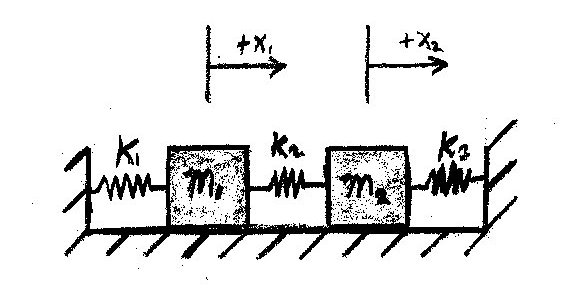Coupled Oscillator: Hellie: Difference between revisions
Jump to navigation
Jump to search
| Line 121: | Line 121: | ||
'''Eigenvalues''' | '''Eigenvalues''' | ||
<math>\lambda_1=-5.29412\,</math> | :<math>\lambda_1=-5.29412\,</math> | ||
<math>\lambda_2=2.83333i\,</math> | :<math>\lambda_2=2.83333i\,</math> | ||
<math>\lambda_3= -2.83333i\,</math> | :<math>\lambda_3= -2.83333i\,</math> | ||
<math>\lambda_4=0\,</math> | :<math>\lambda_4=0\,</math> | ||
| Line 162: | Line 162: | ||
.94046 | .94046 | ||
\end{bmatrix}</math> | \end{bmatrix}</math> | ||
'''Standard Equation''' | |||
:<math>x=c_1k_1e^{\lambda_1 t}+c_2k_2e^{\lambda_2 t}+c_3k_3e^{\lambda_3 t}+c_4k_4e^{\lambda_4 t}</math> | |||
:<math>\ x=c_1</math><math>\begin{bmatrix} | |||
-.05379\\ | |||
.28475 \\ | |||
.17764 \\ | |||
-.94046 | |||
\end{bmatrix}\,</math><math>e^{-5.29412}+ c_2\,</math><math> | |||
\begin{bmatrix} | |||
-.31854i\\ | |||
.90253 \\ | |||
-.09645i\\ | |||
.27326 | |||
\end{bmatrix}\,</math><math>e^{2.83333i}+ c_3\,</math><math>\begin{bmatrix} | |||
.31854i\\ | |||
.90253 \\ | |||
.09645i \\ | |||
.27326 | |||
\end{bmatrix}\,</math><math>e^{-2.83333i}+ c_4\,</math><math>\begin{bmatrix} | |||
-.05379\\ | |||
-.28475 \\ | |||
.17764 \\ | |||
.94046 | |||
\end{bmatrix}, | |||
</math><math>e^{0}\,</math> | |||
Revision as of 11:54, 13 December 2009
Problem Statement
Write up on the Wiki a solution of a coupled oscillator problem like the coupled pendulum. Use State Space methods. Describe the eigenmodes of the system.

Initial Conditions:
State Equations
=
With the numbers...
=
=
Eigenvalues
Eigenvectors
Standard Equation
Eigenmodes
- There are two eigenmodes for the system
- 1) m1 and m2 oscillating together
- 2) m1 and m2 oscillating at exactly a half period difference
Solve Using the Matrix Exponential
=
Written by: Andrew Hellie